by John Pickrell
1. Qrio – the all-dancing bipedal robot
2. Roomba and Scooba – domestic robots
3. The self-replicating robot
4. The spherical security guard
5. Aibo – the robotic pet
6. Stanley – the autonomous car
7. Asimo – the first walking humanoid robot
8. NASA's Mars rovers – labs on wheels
9. The tiniest remote-controlled robot
10. The fly-eating robot
1. Qrio – the all-dancing bipedal robot
Qrio – short for quest for curiosity – is Sony's 58-centimetre-tall, all-dancing, bipedal humanoid robot. Qrio is famous for such feats as conducting the Tokyo Philharmonic Orchestra in a unique rendition of Beethoven's 5th symphony, navigating an assault course, and even roller-skating.
See footage of four QRIOs performing a complicated dance routine, (Windows Media Player required) recorded in December 2003.
2. Roomba and Scooba – domestic robots
Starting in 2002, MIT spin-off iRobot, of Massachusetts, US, finally brought domestic robots to the masses, with their small and affordable Roomba and Scooba vacuuming and mopping robots – retailing at less than $200. Sales of all household robots have boomed, and in 2005 more than a million were thought to be in operation worldwide.
See videos of the Roomba Vacuuming Robot at work on the IRobot Corporation's web site (Macromedia Flash Player required).
3. The self-replicating robot
In 2005 Cornell University researchers, in Ithaca, New York, built the first robot able to create exact copies of itself. The device is built of small mechanical building blocks that can swivel, and also attach themselves to one another using electromagnets. Three or four blocks piled on top of each other to form a tower can create an identical tower by swivelling round like a crane to pick up other nearby blocks and pile them on top of each other.
See footage of the self-replication process (courtesy of Hod Lipson at Cornell University - Windows Media Player required).
4. The spherical security guard
This spherical roving robot designed to detect and report intruders was created in Sweden. It is based on a robot probe originally designed to explore other planets. The automated security guard is propelled by a pendulum suspended from an axis inside the casing, controlled by a motor. Moving the pendulum forwards causes the robot roll along, but the pendulum can also swing from side to side, giving the robot the ability to steer left and right.
See an animation and images of the robot on the Rotundus AB web site (Quicktime required).
5. Aibo – the robotic pet
Aibo – Japanese for companion – is Sony's robotic pooch. It can walk, sit, sleep, beg, yap and perform lots of other convincingly dog-like actions. When Aibo was first released in 1999 it sold out in 20 minutes in Japan - by 2002, 100,000 people owned them.
Brand-new Aibos all behave alike. But over time they develop their own personality as they interact with people. Just how they develop depends on the interaction between their environment and their innate abilities. Aibo owners can also use software to reprogram their pets and add new behaviours.
A short video, available from Sony's research and development lab in Paris, France (Windows Media Player required), shows an Aibo pup that has learnt to play with its toys and bark at another robot nearby.
6. Stanley – the autonomous car
Stanley, an autonomous racing car, has been developed at Stanford University in Palo Alto California. It bagged a $2 million prize in October 2005 for winning the DARPA Grand Challenge, a tough desert race for driverless vehicles.
Stanley has the body of a converted Volkswagen Touareg SUV, and navigates using seven onboard Pentium M computers and an array of devices that includes GPS, four laser range-finders, three cameras, a radar and inertial sensors.
See a video of Stanley at work here on the Stanford University web site (available in several formats).
7. Asimo – the first walking humanoid robot
Asimo, who stands at 130 centimetres tall and weighs 54 kilograms, was the world's first walking humanoid robot. The latest model can run at 6 kilometres an hour, jog in circles and zig-zag. A prototype unveiled in Tokyo, in December 2005, was capable of guiding guests to a meeting room, serving coffee on a tray and pushing a cart with a load of up to 10 kilograms.
See videos of Asimo running and delivering a tray of coffee on the Honda web site (Macromedia Flash Player required).
8. NASA's Mars rovers – labs on wheels
NASA's quad-bike-sized laboratories-on-wheels were built to last just 90 days on Mars and cover no more than 600 metres. But the roving robots have now logged more than an entire Martian year on the surface and collectively covered 12 kilometres of terrain.
See a NASA animation showing how the rovers work (Quicktime required).
9. The tiniest remote-controlled robot
In September 2005, researchers at the University of California in Berkeley created the tiniest mobile robot ever – narrower than a human hair. It is simply a sliver of silicon one hundredth of a millimetre thick. This can be precisely steered - like a remote controlled car - to move in any direction across the surface of a special plate. Powered by a grid of electrodes underneath a surface layer, the bot crawls around at a speed of about 200 micrometers per second and can push specks of dust, or other “dead” robots.
See videos of the tiny bot here here (courtesy of Dartmouth College, available in several formats).
10. The fly-eating robot
Last, but not least, is the unlikely-sounding, fly-eating robot. EcoBot II, designed at the University of West England in Bristol, is part of a drive to make "release and forget" robots that can be sent into dangerous or inhospitable areas to carry out remote industrial or military monitoring.
To survive without human help, a robot needs to be able to generate its own energy. EcoBot ii can do just that, by catching flies and digesting them in a special reactor cell that generates electricity. The downside is that the robot will has to attract the hapless flies using a stinking lure concocted from human excrement.
See videos of the fly-eating robot here on the researchers' web site (available in several formats).


 Paro is a furry white robot modeled after a baby harp seal. Paro can serve as a pet alternative for general households, and research has shown that Paro has therapeutic effects on patients. Paro's entire body is covered in tactile sensors, and its actuators provide it with smooth movement. Lovingly crafted one by one, Paro is recognized for its safety, cleanliness, user-friendliness and durability. About 800 of the robotic seals have been adopted around Japan, and Paro's future plans include overseas travel. [
Paro is a furry white robot modeled after a baby harp seal. Paro can serve as a pet alternative for general households, and research has shown that Paro has therapeutic effects on patients. Paro's entire body is covered in tactile sensors, and its actuators provide it with smooth movement. Lovingly crafted one by one, Paro is recognized for its safety, cleanliness, user-friendliness and durability. About 800 of the robotic seals have been adopted around Japan, and Paro's future plans include overseas travel. [ 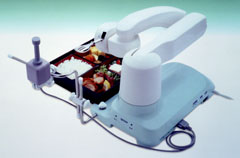 Designed to assist patients unable to use their hands, My Spoon enables users to enjoy ordinary meals by transporting food from a tray to the patient's mouth, one bite at a time. Users can select from three levels of contol — manual (joystick control), semi-automatic or fully automatic — to best suit their physical condition. My Spoon is available outside Japan, in the Netherlands and other locations in Europe. [
Designed to assist patients unable to use their hands, My Spoon enables users to enjoy ordinary meals by transporting food from a tray to the patient's mouth, one bite at a time. Users can select from three levels of contol — manual (joystick control), semi-automatic or fully automatic — to best suit their physical condition. My Spoon is available outside Japan, in the Netherlands and other locations in Europe. [ 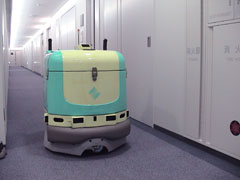 This autonomous robot roams the hallways of buildings, performing cleaning operations along the way. Capable of controlling elevators, the robot can move from floor to floor unsupervised, and it returns to its start location once it has finished cleaning. The robot is currently employed as a janitor at 10 high-rise buildings in Japan, including Harumi Triton Square and Roppongi Hills. [
This autonomous robot roams the hallways of buildings, performing cleaning operations along the way. Capable of controlling elevators, the robot can move from floor to floor unsupervised, and it returns to its start location once it has finished cleaning. The robot is currently employed as a janitor at 10 high-rise buildings in Japan, including Harumi Triton Square and Roppongi Hills. [ 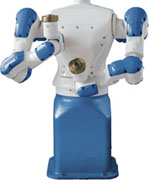 These industrial robot arms are capable of human-like movement, which is great news for factories worried about Japan's shrinking population (and human labor force). The DIA10 consists of two 7-axis arms mounted on a torso. According to
These industrial robot arms are capable of human-like movement, which is great news for factories worried about Japan's shrinking population (and human labor force). The DIA10 consists of two 7-axis arms mounted on a torso. According to 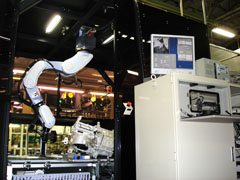 This robot relies on advanced machine vision technology to perform automated inspections on the go. Highly reliable inspections can be performed at each location without stopping the line, allowing for speedier and more cost-effective operations. [
This robot relies on advanced machine vision technology to perform automated inspections on the go. Highly reliable inspections can be performed at each location without stopping the line, allowing for speedier and more cost-effective operations. [ 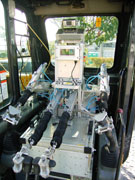 These remote-control unmanned construction machines were originally developed for dangerous recovery operations following disasters such as avalanches and rockslides. Designed to prevent the occurrence of secondary disasters and greatly limit further damage and injury, these robots were deployed at the site of a disastrous mudslide that occurred in Okinawa in June 2006. [
These remote-control unmanned construction machines were originally developed for dangerous recovery operations following disasters such as avalanches and rockslides. Designed to prevent the occurrence of secondary disasters and greatly limit further damage and injury, these robots were deployed at the site of a disastrous mudslide that occurred in Okinawa in June 2006. [ 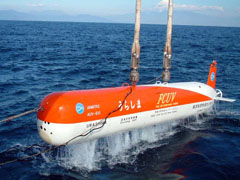 Urashima is a remotely operated vehicle for deep-sea exploration. The 10-meter long vessel relies on hydrogen-based fuel cell batteries that allow it to travel much greater distances than vessels powered by standard lithium-ion batteries. Urashima is expected to play an important role in pre-dive surveys for manned submarines and in the survey of areas considered dangerous for or inaccessible by manned research submarines. [
Urashima is a remotely operated vehicle for deep-sea exploration. The 10-meter long vessel relies on hydrogen-based fuel cell batteries that allow it to travel much greater distances than vessels powered by standard lithium-ion batteries. Urashima is expected to play an important role in pre-dive surveys for manned submarines and in the survey of areas considered dangerous for or inaccessible by manned research submarines. [ 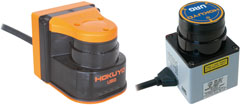 These lightweight, compact laser range finders feature low power consumption, making them ideal sensors for autonomous mobile robots. [
These lightweight, compact laser range finders feature low power consumption, making them ideal sensors for autonomous mobile robots. [ 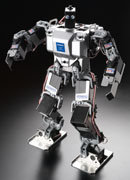 KHR-2HV is a high-performance build-it-yourself biped humanoid robot kit. The popular KHR-2HV is faster, lighter and more agile than its predecessor, KHR-1, and it is packed with more controls, gears, servos and software. Seventeen adjustable joints allow KHR-2HV to perform back flips, cartwheels and human-like moves, and USB connectivity means you can teach it lots of neat tricks. [
KHR-2HV is a high-performance build-it-yourself biped humanoid robot kit. The popular KHR-2HV is faster, lighter and more agile than its predecessor, KHR-1, and it is packed with more controls, gears, servos and software. Seventeen adjustable joints allow KHR-2HV to perform back flips, cartwheels and human-like moves, and USB connectivity means you can teach it lots of neat tricks. [ 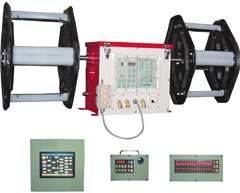 Towa Denki has made a number of improvements to its automated squid-fishing machines since the company began manufacturing them in the 1970s. Relying on functions such as high-tech load detectors, squid finders and water depth detectors, the machines can perform automated operations that boost squid-fishing productivity. [
Towa Denki has made a number of improvements to its automated squid-fishing machines since the company began manufacturing them in the 1970s. Relying on functions such as high-tech load detectors, squid finders and water depth detectors, the machines can perform automated operations that boost squid-fishing productivity. [ 